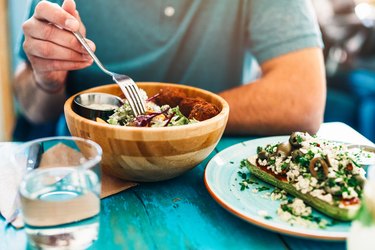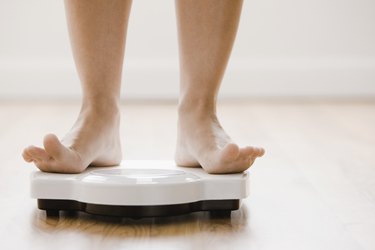
Even if you've never heard of the volumetrics diet, you might already be familiar with the philosophy behind it. Popularized by nutrition science professor and researcher Barbara Rolls, PhD, the diet is based on a pretty straightforward idea: Eat a large volume of low-calorie foods that will help fill you up without weighing you down.
Simple, yes. But is it effective?
Video of the Day
Video of the Day
Below, we break down what the volumetrics diet entails, whether it works for weight loss and talk to experts about its pros and cons. Read on to see if the volumetrics diet may be a smart choice for you.
What Exactly Is the Volumetrics Diet?
The volumetrics diet focuses primarily on the concept of energy density, or the amount of calories packed into certain foods. For example, one cup of broccoli (which is about 30 calories) is significantly less energy-dense than one cup of peanut butter (which is about 1,500 calories).
The volumetrics diet encourages people to load up on high-fiber foods that can be eaten in large quantities and provide satiety for minimal calories, like that broccoli we just mentioned. The idea is not to starve yourself by subsisting solely on fruits and vegetables, but to have produce, soups and salads make up the majority of your meal, with lower-fat dairy and lean meat products acting as sides or supplements.
Rolls' 12-week meal plan divides foods into four categories depending on their energy density. Group one foods are meant to be consumed the most (they're considered "free foods"), while group four foods are to be limited. Portion control is meant to be exercised for foods that fall in between.
Here are a few staples from each group, per the International Food Information Council Foundation:
Group 1: Non-starchy vegetables (think: lettuce, broccoli, cucumbers), broths and skim dairy products
Group 2: Starchier fruits and veggies (like bananas and sweet potatoes), grains, low-fat meat products and legumes
Group 3: Meats, cheeses, higher-fat items like pizza or french fries, breads, ice cream, cakes and dressings
Group 4: Snack foods like crackers, chips and cookies, as well as high-fat ingredients like nuts, butter and various oils
Pros of the Diet
1. It Puts the Spotlight on Fresh Produce
According to New York-based dietitian Laura Burak, RD, CDN, the driving philosophy behind the volumetrics diet is to prioritize fresh produce in order to reach or maintain a healthy weight. "Any responsible dietitian will recommend the exact same thing," she says. "The key to eating more volume is always [to increase your intake of] veggies, and if one thing in nutrition stays true forever, it is the recommendation to focus on filling your diet with lots of fresh foods."
2. It's Not Overly Restrictive
Another advantage of the volumetrics diet? No foods are off-limits. Yep, you read that right. Instead, low-calorie, nutrient-dense items are emphasized, while high-calorie items are consumed in moderation.
"As a registered dietitian in private practice, I have seen countless clients follow these guidelines of adding volume to their diets with high-water, high-volume foods like fruits and vegetables so that they can physically eat more food and naturally take in fewer calories," says Burak. "Plus, this approach allows people to visually see that their plates are full of food, which is also important."
Cons of the Diet
1. It Vilifies Fat
The volumetrics diet places energy-dense foods, which can include healthy fats like olive oil, into group four, aka foods that are meant to be limited. "The categories of food may confuse the average person and discourage them from eating higher-calorie, healthy plant foods like nuts, seeds and avocado," says Burak. "We dietitians are still trying to convince people that healthy fat in your diet does not make you fat, so this old-school way of thinking is not helping us win this battle."
2. It Doesn't Take a Balanced Approach
Lisa Moskovitz, RDN, a New York City-based dietitian and founder of the private practice NY Nutrition Group, says that while the volumetrics plan can help people increase their consumption of fruits and vegetables, "it focuses excessively on low-calorie, high-volume foods as opposed to nutrient density."
"In my professional opinion, this type of eating takes away from mindful and intuitive eating and places a dangerous amount of focus on just trying to eat as much volume of food as possible," Moskovitz tells LIVESTRONG.com. "These behaviors at worst can lead to binge-eating and at least to potentially some type of disordered eating."
3. It's Not Really Sustainable
What's more, the volumetrics diet was originally popularized in a diet book that laid out a 12-week plan and came with sample meals. While this type of plan can be attractive to those looking for structure, it can also give the impression that the diet is something they simply need to follow until they achieve their goals — and then stop, says Burak.
"A way of eating should always be sustainable for the long haul, so think of this approach as more of a set of guidelines rather than a strict diet," recommends Burak. "To put it as simply as possible, focus on fresh plant foods like fruits and veggies and have the other stuff in small amounts."

Does the Volumetrics Diet Work for Weight Loss?
"I believe parts of this diet, if done correctly, can certainly help with weight loss for those who have excess body fat to lose," says Moskovitz. The catch? "As with any fad diet that is not truly customized to the individual, it is always questionable how sustainable it will be."
Friendly reminder: There is no single "best" diet out there. Every body requires a different approach to eating for optimal health. Before subscribing to the meal plan that worked wonders for your best friend, consider working with a registered dietitian to determine which approach will work best for you.
Read more: How to Find the Best Weight-Loss Diet for You
Who Should (and Shouldn’t) Try the Volumetrics Diet?
If you're someone who prefers quantity over quality, this might be the meal plan for you. "If you feel easily deprived or comforted by large portions or quantities of food, the volumetrics diet could work very well for you," Moskovitz says.
Those who have struggled with disordered eating patterns, however, should steer clear of this meal plan. People who have a history of binge-eating may feel triggered by a diet like this, Moskovitz adds.
The Bottom Line
Adding more fruits and vegetables to your diet is never a bad idea, but try not to stress so much about it. The best approach is to apply the guiding principles behind the volumetrics diet to your everyday eating patterns by prioritizing produce and rounding out meals with satiating additions, like good-for-you whole grains and healthy sources of fat and protein.